The last blog posting on 6 January has already let it be known: we are welcoming Sergei Rachmaninoff as a new composer in the Henle catalogue! With the expiration of copyright on 1 January 2014, works in Germany and many other countries of the EU and worldwide have now come into the public domain, so that there is no longer anything standing in the way of a new critical edition of his compositions.
The first works that we are now presenting in January as brand-new Urtext editions are the Corelli Variations (HN 1206), the Études-Tableaux (HN 1202), the 24 Préludes (HN 1200) as well as from the latter, a separate single edition of the Prélude in c sharp minor, Opus 3 No. 2 (HN 1211), certainly the best known of all Rachmaninoff’s pieces.
In the case of a much-played ‘warhorse’ like the c-sharp-minor Prélude, you would think that there could no longer be any questions open to answer. Yet probably just its enormous popularity and its global spread soon after its composition in 1892 led to the fact that to date a blatant error has not been eliminated.
It is a matter of the 2nd eighth-note chord in the left hand in measure 5 that is notated, depending on the edition, now as d sharp, now as d. Each sounds plausible – but which is right? If we consider the autograph (the chord in question is marked here with the red arrow), no accidentals at all are to be seen before the chord, so based on the general key signature the pitches are d sharp1 and d sharp2:
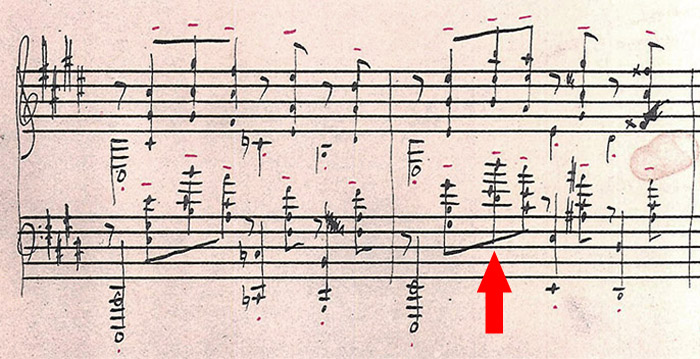
Autograph (facsimile edition, Muzyka publishing house, Moscow, 1977)
But astonishingly enough, the Russian first edition by the Moscow publishing house A.Gutheil gives natural signs and changes these to d1 and d2, respectively:
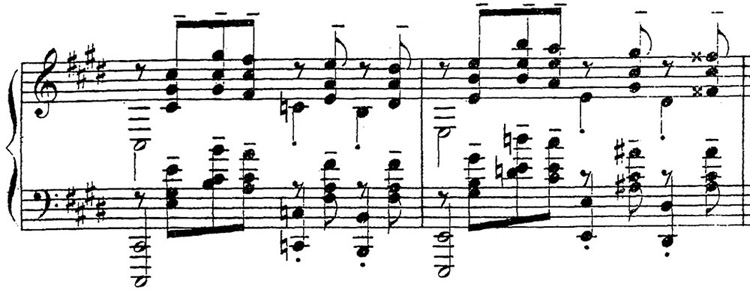
First edition (Gutheil, Moscow, 1893), early issue
Whether this deviation goes back to a deliberate change by Rachmaninoff in the galley proofs (not extant), or was instead an arbitrary intervention by the engraver to whom, perhaps, the clash of seconds, d sharp–e appeared too dissonant, can no longer be clarified.
But it is interesting that in later issues just this spot was repeatedly changed and now sharps were specifically placed before the notes concerned as cautionary accidentals, so to speak:
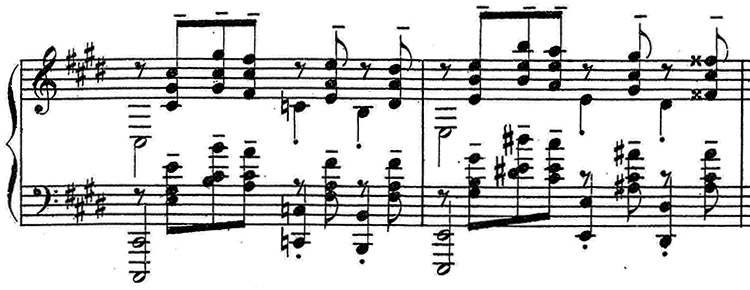
First edition (Gutheil, Moscow, 1893), later issue
We can also recognise the later change from the fact that the form of this sharp differs slightly from the rest of the sharps on the engraved plate, since another punch was obviously used meanwhile; in addition, the leger lines are slightly damaged at the left.
That this correction is according to Rachmaninoff’s wishes is also confirmed by all later editions of the Prélude to appear from Gutheil; newly-engraved by Breitkopf in Leipzig was, in particular, the whole cycle of the 24 Préludes, opening with the c-sharp-minor Prélude – including the corrected d sharp:
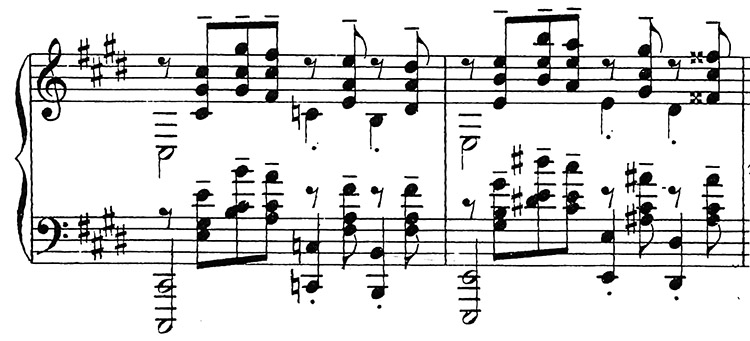
Later complete edition of the 24 Préludes (Gutheil/Breitkopf & Härtel, Moscow/Leipzig, 1911)
(And in case you have grown up with the so-called d and are still ever in doubt – on YouTube you can listen to three recordings made personally by the Master: all of them with the d sharp…)
So, no problem, you would think – the out-of-date copies were soon off the market, certainly revised without exception by Gutheil’s new editions so that the correct d sharp would have become established. Disastrously, though, Gutheil’s edition of 1893 was still not subject to the international copyright protection, so that outside of Russia the c-sharp-minor Prélude was being reprinted (and arranged) worldwide to the publishers’ hearts’ content. And adopted in most of these editions is the obsolete d of the first edition – one example, amongst many, is this early English competing edition of 1896 ‘edited by John A. Preston’:
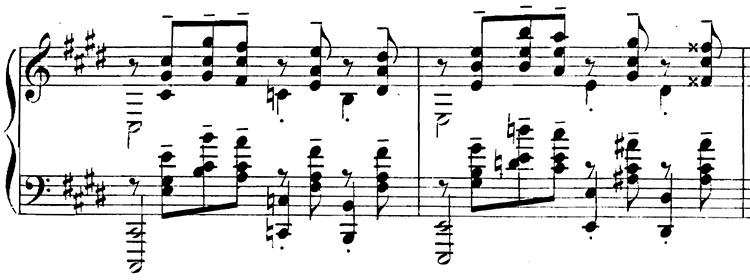
Edition, Bosworth & Co., London/Leipzig, 1896
Since many of these editions are still reprinted unchanged (or served as models for new editions and arrangements), the wrong pitch persistently survives to date in the concert hall and on recordings. Thus, a further good reason always to have recourse to reliable Urtext editions…

Good to know! This is a D natural in all the editions I have.
I understand m.5, but what about m.51, when this section is repeated with octave expansion? In the autograph, does the composer notate using the D Sharp key signature, or modify these notes to D natural accidentals, as all my copies have.
I suppose you refer to measure 48 (click on links to view images)
The situation here is exactly the same as in m.5: the autograph has no accidentals (thus d sharps by the key signature), the corrected first edition then adds the cautionary sharps.
Sorry for my mis-count…yes, m. 48 of course. After listening to Rachmaninoff’s own recordings your reply is validated….many thanks.
Hello, you may be interested to know that in some editions, measures 47, 48, and 52 seem to exclude notes from the left hand. All these chords should have 4 notes, instead of three: Measure 47 beat 2 can miss a G-sharp, beat 2.5 a F-sharp; Measure 48 can miss a B on beat 2 and an A beat 2.5; Measure 52 a G-sharp in beat 2. Many of the free editions on IMSLP have these errors. I would love to learn where these further errors came from!
Yes, very well spotted, and the “culprit” is actually Rachmaninoff himself! As a matter of fact, these notes are already missing in the autograph and in the early issues of the first edition by Gutheil (just like the wrong D mentioned above). Some time later, Rachmaninoff added the notes to the chords, but by then the outdated score had been re-issued and adapted by a myriad of other publishers, and thus the wrong chords “escaped into the wild”…
I have a copy where at the very end of the fast middle part the first chord is a double c# and then after then after it’s the C# E G# C# whereas in other copies that first chord is also the C# E G# C# it’s only in one copy where it also has the D natural and the missing G. Do you know if that’s standard mistake ?
I’ve only seen this mistake (or intervention by the editor?) once, in a later Edition by Augener, revised by a certain O. Thümer. Certainly not approved by Rachmaninoff!
Piano beginner question: m1 shows left hand A’s with no markings, yet in m3 they gain naturals…aren’t they already naturals? Confused here…
You are correct, the notes in m.3 that you mention actually wouldn’t need a natural sign – but since there is an A sharp in the chord right before them, it is customary to add a cautionary natural, even at the lower octave.
What’s the story behind the g natural that appears in a great many editions of the Elegie, from the same opus? On the final page it seems most common to the hear the g natural, although he played a g flat (to clash against the e flat 7 harmony). Did the first edition have the error?
A very good question, which probably will deserve a blog post on its own! I am currently working on our new edition of Opus 3, and I found that Rachmaninoff, in his autograph, unambiguously writes a G flat in the right hand, against the G natural in the left hand. However, Gutheil’s first edition (engraved in Moscow) changed it to G natural, probably an intervention by the engraver (as in the Prelude). Other contemporary editions by Bosworth, Augener, Schott etc. copied that mistake, even Pavel Lamm’s critical edition from the 1950’s has G natural.
I have yet to find a copy of the later edition by Gutheil (re-engraved by Breitkopf in Leipzig) which probably corrected that mistake (as was the case with the Prelude). In any case, Rachmaninoff’s own recordings make it clear that the daring G flat was deliberate.
I’m curious if you could shed some light on the differences in the Études-Tableaux Henle editions D minor etude from the appendix compared to other editions. In the Henle edition it is said that Pavel Lamm published in 1948 and it seems that it is specifically the Pavel Lamm editions that have these differences. Namely differences in measures 13,47,49,55.
In M.13 l: There is an a on the second beat after the arpeggio in the Henle edition but in other editions namely the one by Pavel Lamm there is an f, furthermore you can hear this f in multiple performances of this etude .
In M.47 u: There is a tie on the second beats second 16th note (d) to the 3rd 16th note (also d)(the same passage repeats twice on the measure) on the Henle Edition but on some other editions and some other performances its not played so.
M.49 u: This one is the one difference that is the one that puzzles me the most and is repeated in every performance and could be a mistake of Pavel Lamm. On the second beat of the measure in the Henle Edition there is a 16th note followed by a 16th and 8th notes that have stems together. However as mentioned in every other edition its marked as 16th 8th 16th with stems together. This creates a whole another rhythm. I would really like to know if the Henle edition is the correct version. I’m assuming that the not Henle Edition version is the incorrect one but I would like clarification.
M.55 u: 3rd beats 2nd 16th note is on the Henle Edition a third with a c-natural and e-natural but on other editions the c-natural is omitted on most if not all editions when the passage is repeated on M.57 octave lower the same spot has only a c natural which seems to be consistent in most if not all editions.
There are some other minor differences but these are the most glaring ones especially the one in M.49. Considering the Henle Edition uses the Autograph as a source and there was no other sources to consult I’m curious how did these differences occur.
Hello and sorry for the late reply! I’ve looked up all these passages in the autograph score (the only source for our edition, since this Etude was never published during Rachmaninoff’s lifetime). The answer is: in all instances, our edition has exactly the same text as the autograph, thus we faithfully reproduce Rachmaninoff’s original intentions. Pavel Lamm’s interventions may be inspired by his wish to harmonize analogous measures or to “improve” the text, but they are not supported by the source.
The autograph is not accessible online, but you can find a facsimile in Valentin Antipov’s edition (Sergej Vasilʹevič Rachmaninov. Critical edition of the complete works. Vol.18: Etudes-tableaux. Ed. by Valentin Antipov. Moscow: Russian Music Publishing, 2005)